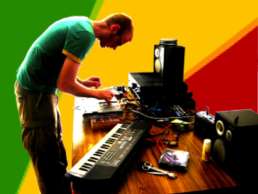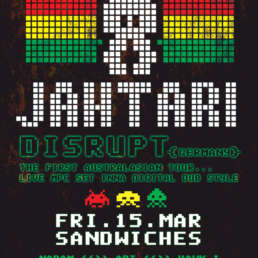Naram talks to Disrupt, founder of Leipzig-based label, Jahtari, who is set to reach Australasian shores this March.
First off, for those Kiwis unfamiliar with your music, can you please explain what exactly Jahtari is?
At heart we’re a Reggae and Dub label, but the mission is to make it work with new sounds that are not usually used in Reggae, like 8-bit aesthetics, wonky drum machine beats or Detroit techno kinda strings and pads. It’s basically roots music, it’s just that our roots aren’t in a Kingston ghetto but in a more run down urban industrial place in the 80s and 90s.
As the name Jahtari suggests, you guys draw nuff influence from 1980s video gaming culture. At New Zealand’s national museum, Te Papa, we’ve just had a major exhibition open exploring the history of video games. What were your favourite games growing up and which had the best soundtracks?
Wow, I’ve got to see that when I’m over! Yeah, games sound-tracks are a massive influence. Without noticing you actually listen to them for hours and days on end, I didn’t realise until years later how much of an impact they actually had on building our musical taste.
My favourite soundtracks are definitely The Secret Of Monkey Island One and Two (1990/91). This is a pirate adventure game set in the Caribbean, so they have an amazing Reggae soundtrack. This was the first Reggae I actually ever heard, we didn’t even know Bob Marley and all that back then. Also Dune One is incredible, it has the best use of the Soundblaster FM chip I’ve ever heard.
Growing up in Communist East Germany, how was it that you actually managed to get hold of these games? Did they run on state-produced alternatives to the Nintendo and Atari consoles we enjoyed in the capitalist West?
It was practically impossible and even forbidden to get anything Western. But a mate was lucky to somehow get a Commodore C16 via some relatives in the West, so we went to his place a lot to play summer games and fuck up the joy-sticks.
I had an East German computer at home called Robotron KC85/3, with pretty similar capabilities to a C16. You could buy some games on cassettes, usually rip-offs of Western arcade hits. So ‘Pacman’ was called ‘Pursuit’ and instead of ghosts chasing pacman you’d have a wolf chasing a rabbit eating carrots and cabbage. ‘Donkey Kong’ was called ‘Ladder’ etc.
As well as the bleeps of blips of video games, you guys clearly draw inspiration from the original digital reggae sound that exploded in Jamaica and the UK in mid-1980s. How did you come to find that sound and who were your favourite purveyors of it?
To be honest, when I first heard digital Reggae I didn’t like it at all, we were more into slow Wackies and Lee Perry dubs back then. But one day Rootah played me the Firehouse comp ‘Soundclash Dubplate Style’ on his big sound system at home and then it made click.
Another crucial influence was the ‘Watch How The People Dancing’ compilation from Honest Jon’s in London, it is a wicked collection of mid 80s UK digital tunes from a sound called Unity. From there we started to dig deeper. It is a very interesting and crazily productive period for JA, somehow it ended almost without warning around 1991.
One thing I hear a lot when I listen to Jahtari stuff, particularly in Rootah’s productions, is this strong Rhythm and Sound-esque dub techno influence. Being fellow East Germans, did those guys have much effect on your musical development?
Actually the Rhythm and Sound guys are both from West Berlin, which always had a mad subculture due to its isolated location, it was like a haven for misfits. But the years after the fall of the wall in 1989 was the time that completely shaped Berlin into what it is today. This was when Techno was fresh, and there were heaps of empty places for parties, real pioneer vibes.
Rootah was straight into Berlin and Detroit techno back then and went to parties in Berlin almost every weekend, as it’s not that far from Leipzig. He always went record shopping at the Hardwax store, which is run by the Rhythm and Sound guys. Their releases as Basic Channel, Maurizio, or the stuff on Chain Reaction or Main Street were crucial. When they started to put out the first Rhythm and Sound and Burial Mix vinyl with Tikiman it opened up a whole new world. Especially it made us realize that Dub and Techno are very close: hypnotic loops with heaps of effects, creating tracks which are more non-linear rather than with the classic verse-chorus-scheme, etc.
Jahtari headquarters are based firmly in Leipzig, which to me seems a city with a very unique atmosphere about it. There’s this sort of dynamic contrast between the massive, gradually-decaying Eastern Bloc infrastructure and this creative effervescence that’s present throughout the city. Could your sound be said to have a similar atmosphere? A sort of retro-futurism?
I never really thought about that, but ‘retro-futurism’ puts it nicely! Reggae in general is a very backward-looking genre, it draws all its inspiration from the golden era in the past, and except the 80s digital tunes about computers and robots there’s no real drive towards the future in it. Techno on the other hand only looks towards the future, or at least that is the way it used to be. So we try to bring that into Dub. There’s definitely an underlying retro-Sci-Fi movie atmosphere in our stuff, from a time when the future actually looked promising instead of grim.
As well of the productions crafted by yourself and Rootah, Jahtari has been responsible for unearthing excess amount of other talented producers from around the world. Tell us about some of the key artists in the Jahtari stable and how you came to link with them.
It’s surprisingly hard to find like-minded musicians who understand what we’re trying to do. Usually it happens by random. (like with you!) For instance, Tapes booked us once for a small show in Brixton and we hung out at his house for a week. Turned out he’s actually a wicked producer, now he has just moved from London to Leipzig and we jam and make heaps of tunes.
Then there’s Julien Neto from Paris, we were on email chatting about music for ages. He is a great ambient producer, but one day he sent a Reggae tune over he had just made which was brilliant. Or there’s Monkey Marc from Melbourne, a master for the grey zone between hip-hop and dub, we’ll release an EP with him next. He played a gig in a squat in Leipzig last year and somehow ended up staying in the city for three more months, so we hooked up and his instrumentals blew us away.
In recent years you’ve also been working with an increasing roster of vocalists. How did the likes of Solo Banton, Mr Williamz and Afrikan Simba react when they first heard your slightly unconventional sound?
Simba is very conscious and probably needs it a bit more classic sounding, but luckily Solo, Soom T or Mr. Williamz were really open for trying out new things.
You originally coined the term ‘Digital Laptop Reggae’ to describe your sound but it seems lately you’ve been moving more and more towards hardware-based production. Can you tell us about your new approach and how it has affected your sound?
I just got bored of looking at a computer screen and clicking around with the mouse. You feel more like a computer technician than a real musician, making music visually, three red clips and now a blue one, copy paste, instead of making tunes with your ears. It also completely misses the hands-on feeling, so at some point I started to abandon the computer as much as possible and do it all with gear. A MPC 1000, some synths and a lot of DIY things.
Learning how to build our own music machines was a blessing, it was way easier than I imagined. We also record a lot straight to multi-track cassette and try to play everything live, doing all the dubs like Jammy and Lee Perry did it. The imperfections and little mistakes you make this way absolutely bring the music to life.
You’ve also changed your approach to live performance. What exactly does a live Jahtari show entail today?
We used to play with a laptop and a play-station controller which was fun for a while, but now I come with an MPC, a Game Boy and some toys and FX machines. All that goes into an analogue mixer so I can dub it up live. So each set is a little different. It’s also great if you have an MC on the sound system, you can react to what they’re doing nicely, those are the best sessions.
Finally, I understand one of your primary reasons for visiting New Zealand’s fair shores is that you’re an obsessive Lord of the Rings fan. Have you seen The Hobbit yet and do you plan to visit Hobbiton?
I wouldn’t say I’m an obsessive fan, mostly the movies got me hooked enough so I want to finally see the amazing New Zealand countryside for real – that’s like another planet for us. A few mates have already been over and absolutely loved it, I just want to grab a tent and a backpack and go hiking.
Oh, and yes, Rootah and me watched the Hobbit already, the day before New Year’s, in a little small town cinema near my parent’s, it was heaps of fun. After smoking a massive Gandalf style rocket that was the perfect thing to watch, you can’t beat a good old treasure hunt yarn. I usually don’t like 3D, but you can appreciate it more from a stoner angle.
More info:
Jahtari website
Jahtarian Rub-a-Dub mixtape for NiceUp on SoundCloud
Catch Disrupt:
Saturday 23 February – LAUNDRY BAR, MELBOURNE
Friday 1 March – COHERENT, AUCKLAND
Sunday 3 March – NEWTOWN SOUND STAGE, NEWTOWN AVE, WELLINGTON
Friday 15 March – SANDWICHES, WELLINGTON
Naram
Related posts
Disrupt Jahtari Mix for NiceUp
January 15, 2013
Disrupt (Jahtari) – Wellington – Fri 15 Mar 2013
March 15, 2013



